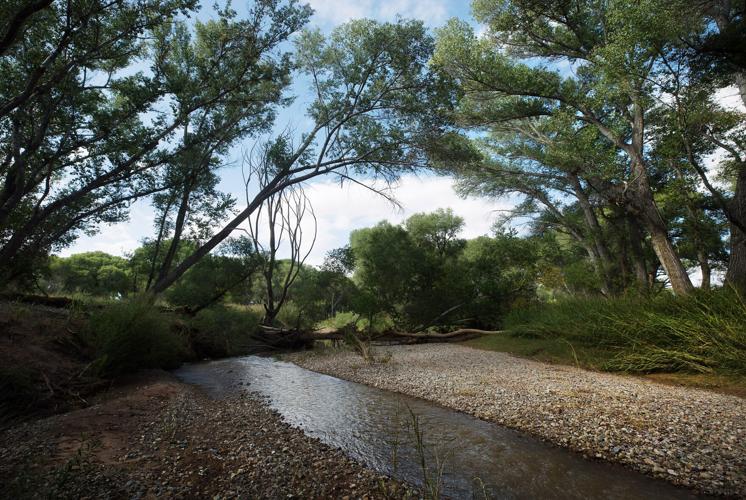A federal appeals court ordered the U.S. Fish and Wildlife Service to revisit its conclusion that Fort Huachuca is adequately compensating for the water it pumps out of the San Pedro River basin.
In the ruling Monday, the 9th Circuit Court of Appeals called the federal agency’s report “arbitrary and capricious.”
The issue could ultimately affect the long-term future of the U.S. Army base.
The court said it was wrong for Fish and Wildlife to accept the fort’s arguments it should get credit for a “conservation easement’’ it had for a 480-acre farm north of Palominas about a mile west of the river. The agency had accepted the argument the land would never be used for farming again.
That meant what had been assessed on a preliminary basis to be a deficit for the fort of 1,180 acre- feet of water — the amount it was drawing out each year beyond recharge of groundwater and other water-savings measures — suddenly turned into a net surplus of at least 1,419 acre-feet.
Based on that, Fish and Wildlife concluded the continued operation of the fort — and specifically the groundwater pumping — would have no impact on the river habitat.
“So what they did is they came up with this scheme to get instant credit for retirement of groundwater pumping that had already been retired a decade early, that was never going to occur again,’’ said environmentalist Robin Silver, a founder of the Tucson-based Center for Biological Diversity, one of the groups that filed suit over the issue.
“This is all fraud, this is a scam,’’ Silver said.
Strictly speaking, Monday’s ruling, unless overturned, simply orders the U.S. Army and the Fish and Wildlife to reevaluate the water-saving analysis and issue a new “biological opinion’’ about the impact of Fort Huachuca on the river basin.
“Downsizing” of fort?
But Silver said the likely outcome is that the new report the 9th Circuit ordered Monday will conclude that ongoing operation of the military base is depleting the groundwater. He said federal funds cannot be used for any operation that a biological opinion concludes endangers at-risk species and their habitats.
That will require “downsizing,” Silver said.
“The fort needs to be closed except for the Electronic Proving Ground,’’ he said, saying that’s probably the one function that cannot be transferred elsewhere.

Silver
There was no immediate response from Fish and Wildlife Service.
Judge Kenneth Lee, writing for the appellate court, said the Endangered Species Act directs Fish and Wildlife to develop a list of threatened or endangered species as well as a list of critical habitats. It then requires each federal agency to ensure, in consultation with the service, any of its operations is not likely to jeopardize the continued existence of a listed species of destroy or adversely modify its designated habitat.
If a preliminary biological assessment by an agency determines there is likely harm to species, then there has to be a formal “biological opinion’’ by Fish and Wildlife. That’s what happened a decade ago.
But prior to that formal opinion, there was a three-way deal in 2013 with Fort Huachuca paying $2.6 million to the Upper San Pedro Partnership.
That organization, formed in 1998, is a consortium of agencies and organizations that has the dual goal of protecting the San Pedro Riparian National Conservation Area and ensuring the long-term viability of Fort Huachuca.
Those funds then enabled the Cochise County Flood Control District to purchase the land near Palominas.
Assumptions assailed
What the fort got for its money was the conservation easement barring future groundwater pumping. Then the Army claimed annual water credits of 2,588 acre-feet — the amount needed to convert the pumping deficit into a surplus.
That, in turn, led to Fish and Wildlife issuing the opinion there was no harm to the San Pedro basin because the Army was relying on that easement and the saved water.
An acre-foot is about 325,000 gallons of water and is considered enough to serve anywhere from two to four families for a year.
Lee said the reasoning was flowed. He said the assumption used by Fish and Wildlife that Fort Huachuca would have a net positive impact on groundwater can be made only if the water savings “were reasonably certain to occur.’’ That requires “solid information’’ that the land would have been used for agriculture if there were no easement, Lee said.
“That reasonable certainty is missing here,’’ the judge wrote. By the time the biological opinion was prepared, “The land had not been used for agricultural purposes for almost a decade,’’ Lee said. He also said some, but not all, of the irrigation infrastructure already had been removed from the land.

All that makes any conclusion the land would otherwise have resumed its agricultural use “speculative,” Lee said.
Therefore, the decision by the Fish and Wildlife that the savings from the easement could be counted on to offset water use on the base was “arbitrary and capricious.’’
Silver said none of this should be a surprise.
He said even the Army, in its own preliminary report, said it would not be able to comply with what’s required under a biological opinion. That would have meant immediate downsizing of the fort, Silver said. That led to the land purchase and the easement.
All totaled, Silver said, the deficit due directly to Fort Huachuca has amounted to about 400,000 acre-feet of water cumulatively from the time base operations started ramping up in the 1960s and 1970s until 2020 when the lawsuit was filed.
“That’s why the river’s going dry,’’ he said.
Long fight in courts
The legal fight traces its roots to the 1999 decision by Fish and Wildlife to designate portions of the San Pedro River as critical habitat.
A 2002 biological opinion found the fort would have no adverse effects, a conclusion rejected by a federal judge.
Another opinion issued after the first one was thrown out conceded that decreased flows in the river would affect the water umbel. That resulted in promises by the fort to conserve water — and a new determination by Fish and Wildlife there would be no adverse impact on endangered species or destruction of critical habitat.
But in 2011 a different federal judge found that biological opinion flawed as not supported by the record or the best available science. Judge Wallace Tashima also said the report “fails to articulate a rational connection between the facts found and the conclusion made.’’
Tashima ruled the Army violated the law requiring it ensure that ongoing and proposed future operations do not jeopardize the existence or habitat of the two species.
That led to another lawsuit filed in 2014 after the failure of the Army and federal officials to come up with a new biological opinion. But that lawsuit was dropped when the opinion was issued later that same year — the opinion that the 9th Circuit just found flawed.
Get your morning recap of today's local news and read the full stories here: tucne.ws/morning







